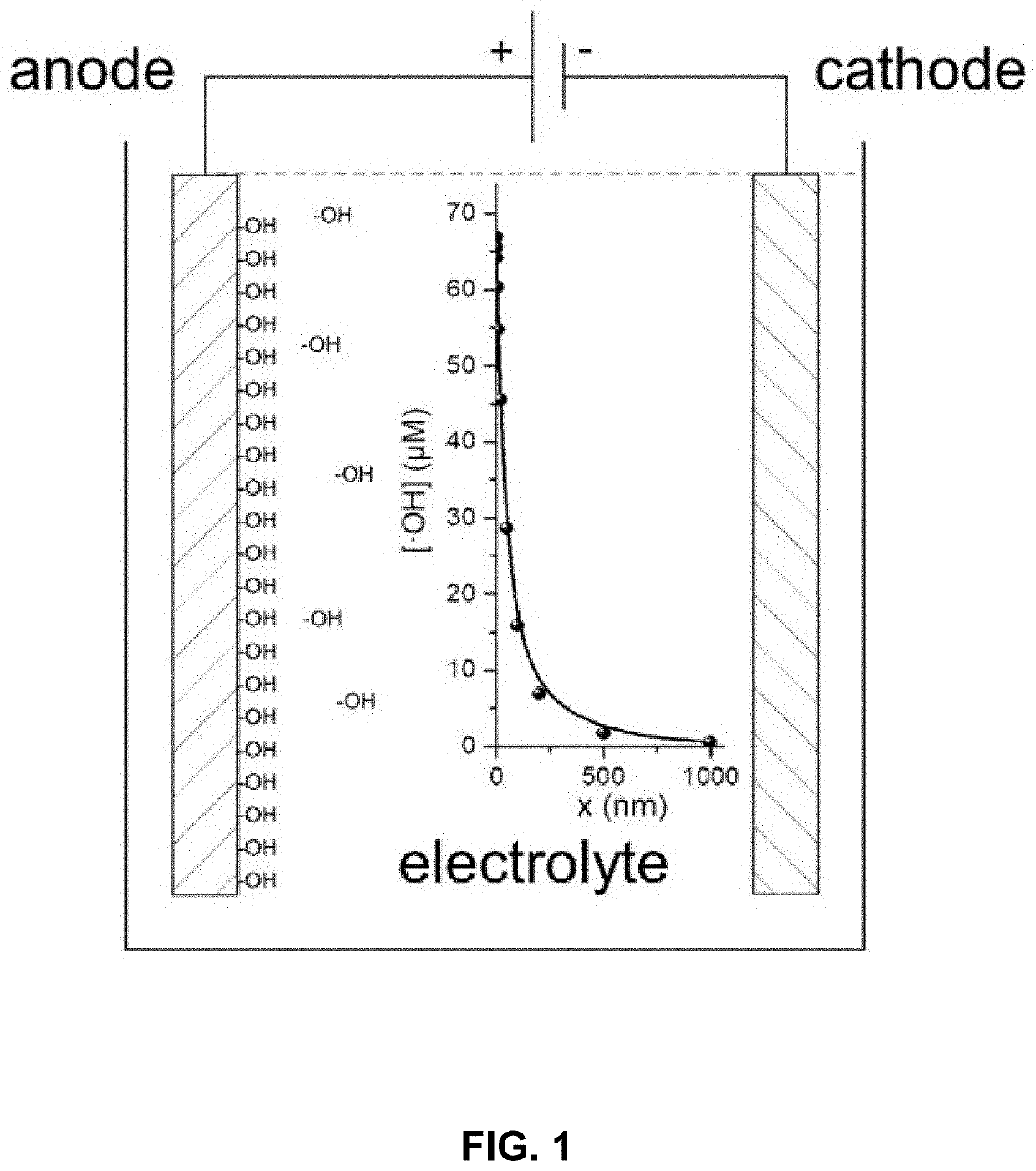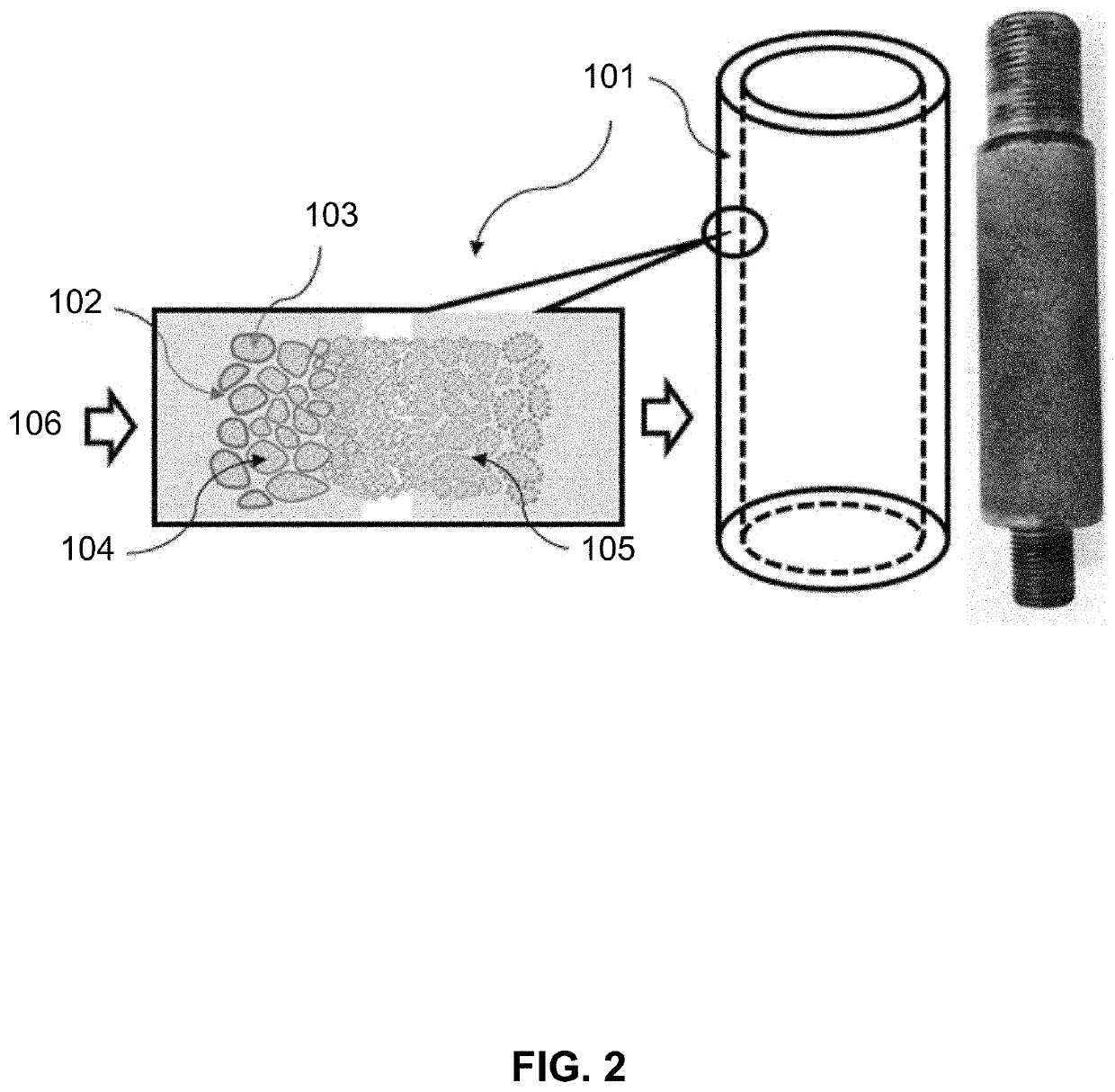"Super-Bubble" Electro-Photo Hybrid Catalytic System for Advanced Treatment of Organic Wastewater
- Summary
- Abstract
- Description
- Claims
- Application Information
AI Technical Summary
Benefits of technology
Problems solved by technology
Method used
Image
Examples
example 1
dic Material Can Generate Hydroxyl Radicals During an Electrocatalytic Process?
[0115]During an electrocatalytic process, the hydroxyl radicals can be generated on the surface of an anode by applying certain cell voltage between anode and cathode. The anodic potential and the anode are the most critical.
[0116]The lower or higher anodic potential (equal to cell voltage under certain condition) cannot yield hydroxyl radical. Considering that free hydroxyl radicals are formed in acid aqueous solution according to Eq (1) (A. Kapalka et al. Electrochimica Acta 54 (2009) 2018-2023), it is possible to calculate the thermodynamic standard potential of its formation using Eq (2-5). The calculated standard potential of 2.38 eV which is the minimum applied potential required to generate hydroxyl radicals is high for a commercial anode.
H2O(I)→.OH(aq)+e− (1)
E0=ΔG0r / ZF (2)
ΔGH2O=−237.178 kJ mol−1 (3)
Δi G.OH=−7.74 kJ mol−1 (4)
E0(.OH)=2.38 eV (5)
H2O(I)→H2+½O2 (6)
E0(O2)=1.51 eV (7)
[0117]U...
example 2
he Hydroxyl Radicals Short-Lived in an Ordinary Electrocatalytic Process?
[0119]Hydroxyl radical (.OH) is a very active oxidizing radical, and its standard electrode potential (2.80 V) is only inferior to fluorine (2.87 V). The rate constant of reaction with organic matter is large, generally in 106˜1010 mol L−1 s−1. It is unselective: almost all organic matter can be oxidized. It is also short-lived: hydroxyl radical lifetime is different in different environmental media, but generally less than 10−4 s. The typical kinetics of hydroxyl radical related reactions occur in an electrocatalytic environment are as follows (Table 2 and Eq (8-12)):
TABLE 2Typical reaction for the generationand quenching of hydroxyl radicals.ReactionsKinetics parameterS + H2O (I) → S (H2O)adk1(m s−1) = 2.83 × 10−5k−1(m s−1) = 3.95 × 10−3S (H2O)ad → S (•OH)ad + H+(ac) + e−k2(mol m−2 s−1) = 3.23 × 10−9k−2(mol m−2 s−1) = 0.76S (•OH)ad → S(•O)ads + H(ac) + e−k3(mol m−2 s−1) = 2.72 × 10−3k−3(mol m−2 s−1) = 4.01 × ...
example 3
e Theoretical Diffusion Layer of Hydroxyl Radicals so Limited?
[0120]According to the literature report, at current density (j=300 A m−2), the reaction layer thickness is about 1 μm whereas the maximum (surface) concentration of hydroxyl radicals reaches the value of several tenths of μM (Quim. Nova vol. 34 no. 5 São Paulo 2011). It can be calculated by the concentration profile of hydroxyl radicals on anodes:
[0121]By applying one-dimensional Fick law referred to the molecular diffusion in a stagnant layer, the mass balance for hydroxyl radicals in an element of width Δx can be expressed as:
-DHO•[dcHOdx]x-4kHO•cHO2•Δx=-DHO•[dcHO•dx]x+Δx
where DHO. (m2 s−1) is the diffusion coefficient of HO., kHO. (m3 mol−s−1) is the rate constant of reaction, and cHO. (mol m−3) is the concentration of HO.. If x goes to 0, we can write
DHO•d2cHO•dx2=4kHO•cHO•2
Considering these boundary conditions, the solution of differential equation gives the concentration profile of ...
PUM
| Property | Measurement | Unit |
|---|---|---|
| Fraction | aaaaa | aaaaa |
| Time | aaaaa | aaaaa |
| Time | aaaaa | aaaaa |
Abstract
Description
Claims
Application Information
 Login to View More
Login to View More - R&D
- Intellectual Property
- Life Sciences
- Materials
- Tech Scout
- Unparalleled Data Quality
- Higher Quality Content
- 60% Fewer Hallucinations
Browse by: Latest US Patents, China's latest patents, Technical Efficacy Thesaurus, Application Domain, Technology Topic, Popular Technical Reports.
© 2025 PatSnap. All rights reserved.Legal|Privacy policy|Modern Slavery Act Transparency Statement|Sitemap|About US| Contact US: help@patsnap.com



